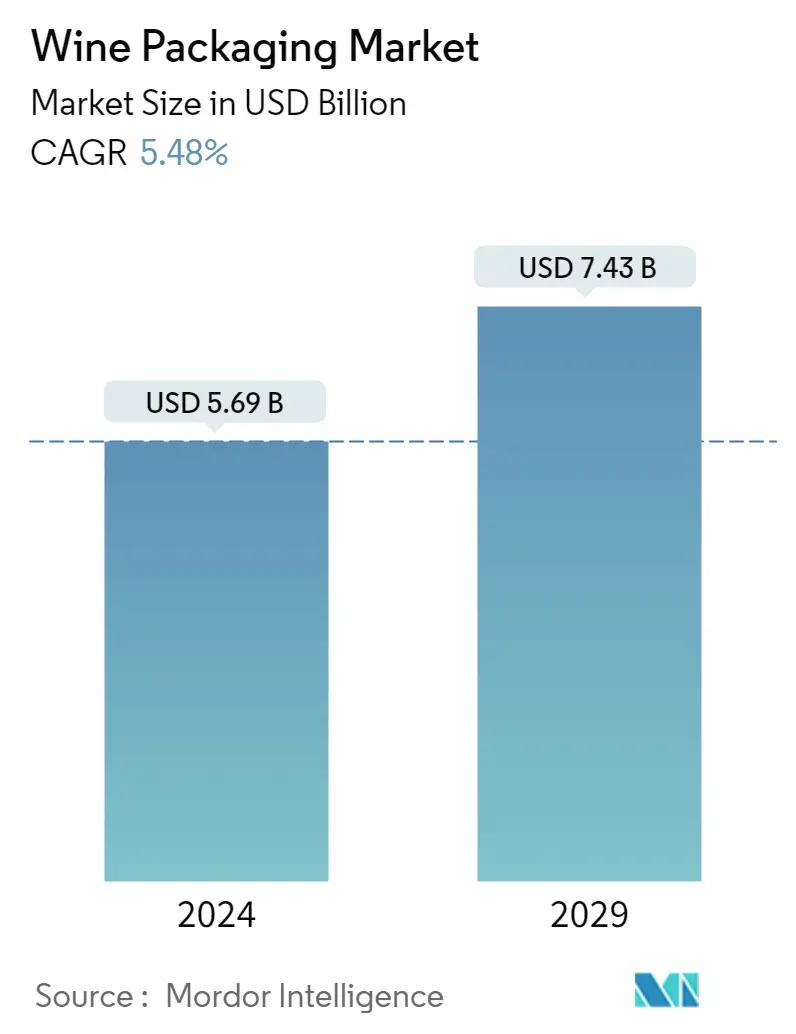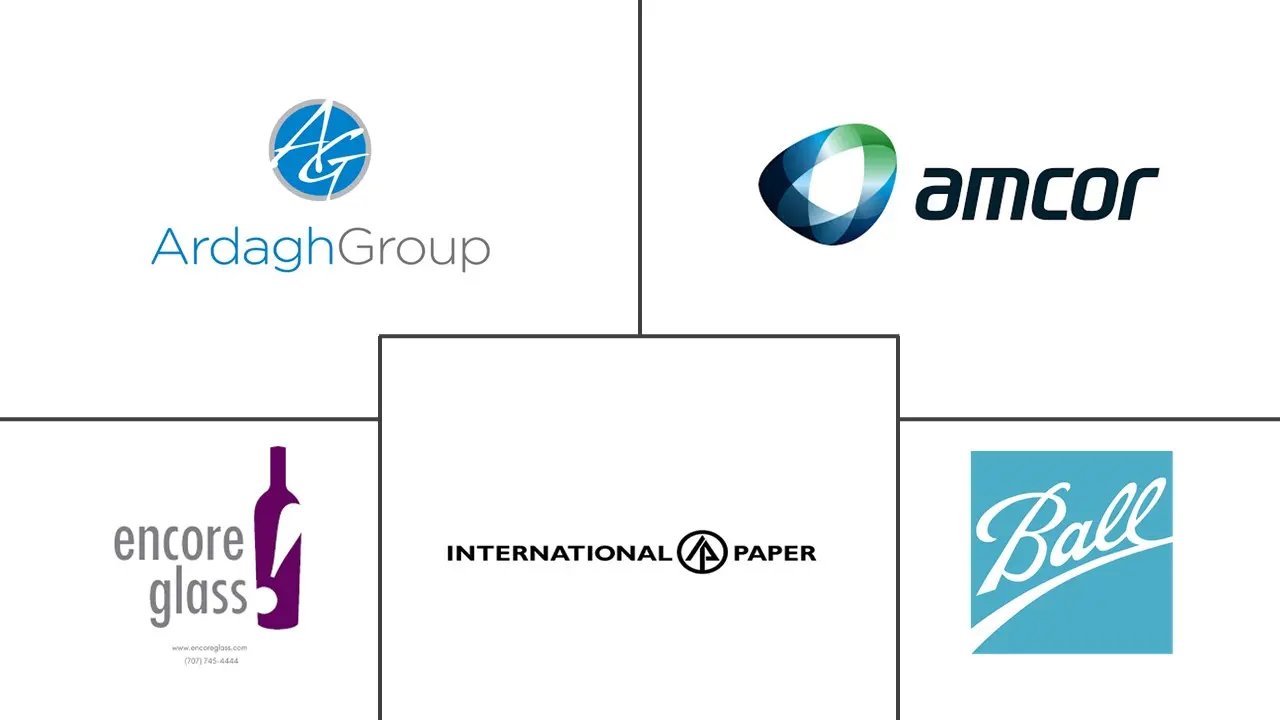Market Size of Wine Packaging Industry

| Study Period | 2018 - 2029 |
| Market Size (2024) | USD 5.69 Billion |
| Market Size (2029) | USD 7.43 Billion |
| CAGR (2024 - 2029) | 5.48 % |
| Fastest Growing Market | Asia Pacific |
| Largest Market | North America |
| Market Concentration | Low |
Major Players
*Disclaimer: Major Players sorted in no particular order |
Wine Packaging Market Analysis
The Wine Packaging Market size is estimated at USD 5.69 billion in 2024, and is expected to reach USD 7.43 billion by 2029, growing at a CAGR of 5.48% during the forecast period (2024-2029).
Some popular emerging trends expected to become regular in wine packaging are twist-off corks, bottle wraps, thinner eco-glass, laser-cut labels, etched glass, and shrink-wrap sleeves.
- The growing wine demand and evolving consumer behavior towards packaging aid the opportunities in wine packaging. Due to the increased competitiveness in wine markets, companies are now focusing on acquiring information about their customers' requests to cater to changing customer demand. Additionally, according to the International Organisation of Vine and Wine (OIV), in 2021, the United was the most significant wine consumer in the world, with 33.1 million hectoliters, followed by France, Italy, and Germany, with 25.2, 24.2, and 19.8 million hectoliters respectively.
- Additionally, with the rise of Italian wine production as the standard, new business opportunities are being created in this rapidly growing market. Also, Modern B2B Marketplace platform helps buyers and sellers identify new product sourcing opportunities with the best production experts from the top wine vineyards in Italy. This allows wine manufacturers to their online presence and marketing products, thus boosting their sales.
- Also, while purchasing wine, consumers look for aspects such as a retail shelf, packaging, labeling, etc. This packaging protects and preserves the wine from within and is also used as a marketing tool. Wine packaging is a way to influence the customer's perception and, ultimately, acceptance of the product. With wine, the package appears to have a more significant influence over the consumer than other extrinsic cues such as brand name, price, etc.
- Moreover, manufacturers are increasingly using innovative materials such as metal, cork, and rubber to make wine bottles stronger, recyclable, and resealable. Wine packaging manufacturers focus on reducing their environmental footprint and formulating highly eco-friendly and sustainable solutions for packaging.
- However, despite its strength, cardboard can be dented, crushed, or damaged under some conditions. Also, they are not waterproof and cannot withstand weather conditions like snow or rain, and they prove ineffective while keeping the product inside the box free from water and snow molecules.
- Covid-19 impacted many organizations and enterprises outside the medical and emergency sectors, creating a ripple effect across the globe. Many industries, like wine packaging, were sterilized by the introduction of social distancing and lockdown on a global scale. The impacts of pandemic affected wine purchases. As per the study by Wittwer and Anderson, there was a reduction in the value of domestic consumption of wine by 14% due to the insurgence of the covid-19 virus in Western Europe. Further, the Russia-Ukraine war has an impact on the overall packaging ecosystem.
Wine Packaging Industry Segmentation
The process of providing a protective and informative covering to the product so that it helps to protect the product during its handling, storage, and movement is termed packaging. It provides valuable information about the content of the package.
The study tracks the demand for the packaging market through the revenue derived from glass, plastic, metal, and paperboard. It also includes the effect of regulations and drivers on market growth. The Wine Packaging Market is segmented by Packaging Material (Glass, Plastic, Metal, Paperboard), Product Type (Glass Bottles, Plastic Bottles, Bag in Box, Closures), and Geography. The market sizes and projections are provided in USD million for all the mentioned segments.
| Material Type | |
| Glass | |
| Plastic | |
| Metal | |
| Paper Board |
| Product Type | |
| Glass Bottles | |
| Plastic Bottles | |
| Bag in Box | |
| Closures (Natural Corks, Synthetic Corks, Aluminum Screw Caps, and Others) | |
| Other Product Types |
| Geography | ||||||||
| ||||||||
| ||||||||
| ||||||||
| Latin America | ||||||||
| Middle East and Africa |
Wine Packaging Market Size Summary
The wine packaging market is poised for significant growth, driven by evolving consumer preferences and increasing demand for wine globally. As companies strive to meet the changing demands of consumers, they are adopting innovative packaging solutions such as twist-off corks, eco-friendly materials, and advanced labeling techniques. The market is characterized by a shift towards sustainable and recyclable packaging options, with manufacturers focusing on reducing their environmental impact. The rise of Italian wine production and the expansion of B2B marketplaces are creating new opportunities for wine packaging providers to enhance their online presence and reach a broader audience. The packaging not only serves as a protective measure but also plays a crucial role in marketing, influencing consumer perception and acceptance of the product.
The market landscape is highly fragmented, with numerous small players and prominent global companies like Amcor Limited and Ardagh Group SA leading the charge in innovation. The demand for alternative packaging solutions, such as recyclable plastic and aluminum, is growing due to their lighter weight and reduced shipping costs. The impact of global events, such as the COVID-19 pandemic and the Russia-Ukraine war, has also shaped the market dynamics, affecting wine consumption and packaging strategies. In the United States, the premiumization of wines and changing demographics, particularly among millennials and boomers, are driving the need for new packaging solutions. Local wine packaging providers are leveraging these trends to introduce product innovations, further fueling market growth.
Wine Packaging Market Size - Table of Contents
-
1. MARKET DYNAMICS
-
1.1 Market Overview
-
1.2 Industry Value Chain Analysis
-
1.3 Industry Attractiveness - Porter's Five Forces Analysis
-
1.3.1 Bargaining Power of Suppliers
-
1.3.2 Bargaining Power of Consumers
-
1.3.3 Threat of New Entrants
-
1.3.4 Threat of Substitute Products
-
1.3.5 Intensity of Competitive Rivalry
-
-
1.4 Market Drivers
-
1.4.1 Innovative Packaging and Attractive Marketing
-
-
1.5 Market Challenges
-
1.5.1 Stringent Environmental Regulations
-
1.5.2 Wine-related Human Health Concerns
-
-
1.6 Impact of COVID-19 on the Wine Packaging Industry
-
-
2. MARKET SEGMENTATION
-
2.1 Material Type
-
2.1.1 Glass
-
2.1.2 Plastic
-
2.1.3 Metal
-
2.1.4 Paper Board
-
-
2.2 Product Type
-
2.2.1 Glass Bottles
-
2.2.2 Plastic Bottles
-
2.2.3 Bag in Box
-
2.2.4 Closures (Natural Corks, Synthetic Corks, Aluminum Screw Caps, and Others)
-
2.2.5 Other Product Types
-
-
2.3 Geography
-
2.3.1 North America
-
2.3.1.1 United States
-
2.3.1.2 Canada
-
-
2.3.2 Europe
-
2.3.2.1 United Kingdom
-
2.3.2.2 Germany
-
2.3.2.3 Italy
-
2.3.2.4 France
-
2.3.2.5 Spain
-
2.3.2.6 Rest of Europe
-
-
2.3.3 Asia Pacific
-
2.3.3.1 China
-
2.3.3.2 Japan
-
2.3.3.3 Australia and New Zealand
-
2.3.3.4 Rest of Asia Pacific
-
-
2.3.4 Latin America
-
2.3.5 Middle East and Africa
-
-
Wine Packaging Market Size FAQs
How big is the Wine Packaging Market?
The Wine Packaging Market size is expected to reach USD 6.00 billion in 2025 and grow at a CAGR of 5.48% to reach USD 7.84 billion by 2030.
What is the current Wine Packaging Market size?
In 2025, the Wine Packaging Market size is expected to reach USD 6.00 billion.

